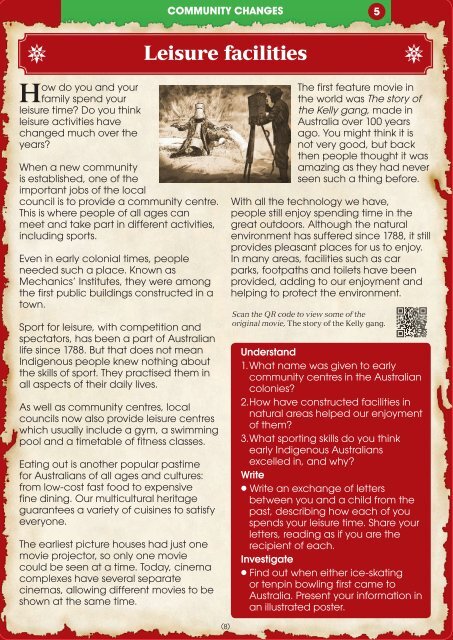The History Box 3 - An Inquiry Approach - Sample unit
Create successful ePaper yourself
Turn your PDF publications into a flip-book with our unique Google optimized e-Paper software.
COMMUNITY CHANGES<br />
5<br />
Leisure facilities<br />
How do you and your<br />
family spend your<br />
leisure time? Do you think<br />
leisure activities have<br />
changed much over the<br />
years?<br />
When a new comm<strong>unit</strong>y<br />
is established, one of the<br />
important jobs of the local<br />
council is to provide a comm<strong>unit</strong>y centre.<br />
This is where people of all ages can<br />
meet and take part in different activities,<br />
including sports.<br />
Even in early colonial times, people<br />
needed such a place. Known as<br />
Mechanics’ Institutes, they were among<br />
the first public buildings constructed in a<br />
town.<br />
Sport for leisure, with competition and<br />
spectators, has been a part of Australian<br />
life since 1788. But that does not mean<br />
Indigenous people knew nothing about<br />
the skills of sport. <strong>The</strong>y practised them in<br />
all aspects of their daily lives.<br />
As well as comm<strong>unit</strong>y centres, local<br />
councils now also provide leisure centres<br />
which usually include a gym, a swimming<br />
pool and a timetable of fitness classes.<br />
Eating out is another popular pastime<br />
for Australians of all ages and cultures:<br />
from low-cost fast food to expensive<br />
fine dining. Our multicultural heritage<br />
guarantees a variety of cuisines to satisfy<br />
everyone.<br />
<strong>The</strong> earliest picture houses had just one<br />
movie projector, so only one movie<br />
could be seen at a time. Today, cinema<br />
complexes have several separate<br />
cinemas, allowing different movies to be<br />
shown at the same time.<br />
<strong>The</strong> first feature movie in<br />
the world was <strong>The</strong> story of<br />
the Kelly gang, made in<br />
Australia over 100 years<br />
ago. You might think it is<br />
not very good, but back<br />
then people thought it was<br />
amazing as they had never<br />
seen such a thing before.<br />
With all the technology we have,<br />
people still enjoy spending time in the<br />
great outdoors. Although the natural<br />
environment has suffered since 1788, it still<br />
provides pleasant places for us to enjoy.<br />
In many areas, facilities such as car<br />
parks, footpaths and toilets have been<br />
provided, adding to our enjoyment and<br />
helping to protect the environment.<br />
Scan the QR code to view some of the<br />
original movie, <strong>The</strong> story of the Kelly gang.<br />
Understand<br />
1. What name was given to early<br />
comm<strong>unit</strong>y centres in the Australian<br />
colonies?<br />
2. How have constructed facilities in<br />
natural areas helped our enjoyment<br />
of them?<br />
3. What sporting skills do you think<br />
early Indigenous Australians<br />
excelled in, and why?<br />
Write<br />
• Write an exchange of letters<br />
between you and a child from the<br />
past, describing how each of you<br />
spends your leisure time. Share your<br />
letters, reading as if you are the<br />
recipient of each.<br />
Investigate<br />
• Find out when either ice-skating<br />
or tenpin bowling first came to<br />
Australia. Present your information in<br />
an illustrated poster.<br />
(8)
Leisure facilities<br />
Across the country in urban, suburban, rural and semirural areas, leisure facilities<br />
are constantly being established, renovated or demolished. It is likely that some of<br />
the facilities you and your family use today were not available in their current form<br />
when your parents or grandparents were your age; and there may be some facilities,<br />
enjoyed by earlier generations, that do not exist today.<br />
Before<br />
After<br />
Beatty Park Leisure Centre in Perth, WA, before it closed for renovations in 2011 and after it reopened in 2013<br />
Constructed fences and paths along the Victorian coastline,<br />
protecting the environment and those who want to enjoy it<br />
<strong>The</strong> Boomerang Cinema in Coogee, NSW, which was demolished<br />
in early 1959. Today an apartment block, Windsor Towers,<br />
stands in its place.<br />
Playing minigolf is a popular way to<br />
spend an hour or two in the open air. It<br />
is a pastime that has spread across the<br />
country in the past fi fty years, like this<br />
course in South Australia. It is unlikely<br />
something your grandparents played<br />
when they were your age.<br />
Write<br />
• Write a list of categories you would<br />
use to group the leisure facilities in<br />
your local area.<br />
Research<br />
• Use your list of categories to create<br />
a chart showing the number of each<br />
type of leisure facility in your local area.<br />
R.I.C. PUBLICATIONS ® ricpublications.com.au THE HISTORY BOX—YEAR 3 ISBN 978-1-925698-29-9
COMMUNITY CHANGES<br />
Leisure facilities – 1<br />
Local council services<br />
INTRODUCTION<br />
Today’s council-run comm<strong>unit</strong>y and leisure centres and libraries are the modern version of the early Mechanics’<br />
Institutes: places where people could gather for social activities, take part in courses to learn new skills and<br />
borrow books and other reading materials.<br />
ACTIVITY<br />
• In groups, discuss the purpose of local council comm<strong>unit</strong>y and leisure facilities. Why are they provided and for<br />
whom?<br />
• Create a list of council comm<strong>unit</strong>y and leisure facilities used by students and their families in the local area.<br />
• How important are these facilities to the students? What are their earliest memories of them? How would they<br />
feel if any one of them was to close?<br />
CONNECTION<br />
A comm<strong>unit</strong>y centre for the social wellbeing of local residents has always been a key feature of any new<br />
settlement or suburb. Over time, they have provided a greater variety of activities for local residents of all ages.<br />
R.I.C. PUBLICATIONS ® ricpublications.com.au (29) THE HISTORY BOX 3 ISBN 978-1-925698-29-9
INTRODUCTION<br />
COMMUNITY CHANGES<br />
Leisure facilities – 2<br />
Dining out<br />
Dining out can mean anything from sitting down to a fast-food meal-in-a-box, relaxing at a fancy restaurant with<br />
tablecloths and different-sized cutlery for each course, or enjoying a meal at a friend’s or family member’s house.<br />
ACTIVITY<br />
• Discuss the different places where students and their families dine out. Agree on a suitable way to categorise<br />
them.<br />
• Discuss the different cuisines available and which are the most popular.<br />
• Consider which categories and cuisines may and may not have been available to their parents and<br />
grandparents when they were their age.<br />
CONNECTION<br />
<strong>The</strong> variety of categories and cuisines has increased for a number of reasons, including the end of the White<br />
Australia policy, the introduction of fast-food chains and changing social habits.<br />
R.I.C. PUBLICATIONS ® ricpublications.com.au (30) THE HISTORY BOX 3 ISBN 978-1-925698-29-9
INTRODUCTION<br />
COMMUNITY CHANGES<br />
Leisure facilities – 3<br />
Cinemas<br />
Since the early days of silent movies and ‘the talkies’, visiting the cinema has been a popular pastime all over the<br />
world. But the movie experience of today is quite different from the ones our parents and grandparents would<br />
have enjoyed.<br />
ACTIVITY<br />
• Discuss the many features of a cinema today, including the number of screens and movies, ratings, daily<br />
showings, food availability and buying tickets.<br />
• Discuss how frequently students visit the cinema and what they enjoy about the experience.<br />
• Discuss other technology used to show movies. What are the advantages and disadvantages of watching a<br />
movie by each method?<br />
CONNECTION<br />
Today, it is not necessary to visit the cinema to see a movie. Movies are shown on free-to-air and paid TV, and<br />
they can be watched through the internet and on DVD. With all this competition, cinemas have to provide more<br />
than a ‘watch the movie’ experience.<br />
R.I.C. PUBLICATIONS ® ricpublications.com.au (31) THE HISTORY BOX 3 ISBN 978-1-925698-29-9
INTRODUCTION<br />
COMMUNITY CHANGES<br />
Leisure facilities – 4<br />
<strong>The</strong> natural environment<br />
What exactly is the ‘natural environment’? In over two hundred years, much of the natural environment has<br />
been lost or changed due to development and the introduction of non-native plant and animal species. But people<br />
still enjoy spending time in the great outdoors: on a constructed golf course or park, at the beach or in the bush.<br />
ACTIVITY<br />
• Discuss the different activities students and their families do in the great outdoors and where they occur.<br />
• Decide on criteria for natural and constructed environments and categorise the activities conducted<br />
in each.<br />
• Discuss how and why local councils protect some natural environments.<br />
• Discuss ways in which we continue to damage natural environments even though we know the consequences.<br />
CONNECTION<br />
In recent years, we have become more aware of protecting the natural environment and repairing the damage<br />
done by generations of people who did not realise the effects of their actions.<br />
R.I.C. PUBLICATIONS ® ricpublications.com.au (32) THE HISTORY BOX 3 ISBN 978-1-925698-29-9
COMMUNITY CHANGES Leisure facilities – 1<br />
R A 1<br />
C<br />
E/R<br />
Local council services<br />
All local councils provide comm<strong>unit</strong>y facilities for the use and<br />
enjoyment of local residents. How have they changed over the years?<br />
(a) Brainstorm and record examples of leisure facilities local councils might<br />
provide for residents.<br />
(b) Download a street map of your local suburb or area and one established<br />
at a different time, either older or younger. Study the maps carefully and<br />
highlight the location of any facilities suggested in part (a).<br />
(c) Compare the two maps and complete a Similarities and differences chart.<br />
(d) Write a brief summary of the facilities in both areas.<br />
Q R 2<br />
E/R<br />
C<br />
(a) On a 5Ws and H chart, write research questions to learn more about a<br />
council leisure facility in your area including its use by residents, now and in<br />
the past.<br />
(b) Imagine the council announced plans to sell this site to developers who<br />
wanted to build a block of apartments. How would you feel about it? Write<br />
arguments in support of or against the plans.<br />
(c) As a class, role-play a council meeting in which you present your ideas and<br />
discuss the plans.<br />
32<br />
THE HISTORY BOX 3 ISBN 978-1-925698-29-9<br />
R.I.C. PUBLICATIONS ® www.ricpublications.com.au
COMMUNITY CHANGES Leisure facilities – 2<br />
Q R 1<br />
A E/R C<br />
Dining out<br />
Dining out is a popular way for families and friends to spend time<br />
together. Today, there are so many options of cuisines and dining<br />
styles for us to choose. But it has not always been like this.<br />
(a) On a 5Ws and H chart, pose multiple-choice questions for a survey to ask<br />
people of different generations about their dining out experiences when they<br />
were your age.<br />
(b) On a separate piece of paper, show the results of your survey in graphs or<br />
diagrams.<br />
(c) Write a brief summary of your results.<br />
R E/R 2 (a) Foods from different countries are available to us through chain restaurants<br />
and through independent restaurants. Give some examples of each type of<br />
restaurant in your local area.<br />
Chain restaurants<br />
Independent restaurants<br />
(b) Independent restaurants are often family-run businesses offering authentic<br />
food from the owners’ home country. What do you think independent<br />
restaurants in a place can tell us about the history of migration to that<br />
place?<br />
R.I.C. PUBLICATIONS ® www.ricpublications.com.au THE HISTORY BOX 3 ISBN 978-1-925698-29-9 33
COMMUNITY CHANGES Leisure facilities – 3<br />
Q R 1<br />
A<br />
E/R<br />
Cinemas<br />
<strong>The</strong>re is no doubt that for people of your grandparents’ generation,<br />
a visit to the cinema today is very different from when they were<br />
younger.<br />
(a) On an interview script chart, pose questions to ask people of different<br />
generations about visits to the cinema when they were your age.<br />
(b) From the answers you receive, write what has changed and what has stayed<br />
the same.<br />
What has changed?<br />
What has stayed the same?<br />
(c) What reasons for visiting the cinema in the past and in the present do you<br />
think are the same and different?<br />
Reasons that are the same<br />
Reasons that are different<br />
C<br />
2 Present a role-play in which a person either from the present travelling back in<br />
time or from the past, travelling forward in time, tells friends about a visit to the<br />
cinema in his or her era.<br />
34<br />
THE HISTORY BOX 3 ISBN 978-1-925698-29-9<br />
R.I.C. PUBLICATIONS ® www.ricpublications.com.au
COMMUNITY CHANGES Leisure facilities – 4<br />
<strong>The</strong> natural environment<br />
<strong>The</strong> natural environment we know today is very different from the<br />
one of the 18th century but it is still important for us to treat it with<br />
care and do our best to preserve it for future generations.<br />
R E/R 1 (a) Where do you enjoy the great outdoors? Give examples of constructed and<br />
natural environments you enjoy.<br />
Constructed environments<br />
Natural environments<br />
(b) List any constructed features that exist in a natural environment you enjoy.<br />
(c) How do you think adding constructed features to a natural environment<br />
helps us to connect with and protect that environment?<br />
Q R 2<br />
A E/R C<br />
(a) On an interview script chart, pose questions to ask people of different<br />
generations about your chosen natural environment in Question 1 (b).<br />
(b) From the answers you receive, summarise what has changed and what has<br />
stayed the same.<br />
R.I.C. PUBLICATIONS ® www.ricpublications.com.au THE HISTORY BOX 3 ISBN 978-1-925698-29-9 35
COMMUNITY CHANGES Assessment – 1<br />
Name:<br />
Date:<br />
1 Before the Swan River Colony was established, the land was covered with:<br />
a forests b desert c wetlands d mountains<br />
2 <strong>The</strong> colonists in all parts of Australia:<br />
a followed the Indigenous ways of using the land.<br />
b shared their ideas about the land with Indigenous Australians.<br />
c<br />
used European ways to develop the land.<br />
3 Erosion of sand is caused by:<br />
a human activity.<br />
b natural forces.<br />
4 Tick all that apply. <strong>The</strong> natural environment of Australia has been damaged by:<br />
a Indigenous Australians<br />
b non-Indigenous Australians<br />
c<br />
native species<br />
d introduced species<br />
5 <strong>The</strong>re is no use for old buildings in modern cities.<br />
a Fact b Opinion<br />
6 High-rise towers are built because they:<br />
a make a place look modern.<br />
b provide great views.<br />
7 New suburbs are built because:<br />
a people want new homes.<br />
b the population is increasing.<br />
8 Tick all that apply. Shared footpaths are for:<br />
c<br />
c<br />
have a small footprint.<br />
older suburbs are demolished.<br />
a walkers only.<br />
b walkers with dogs and prams.<br />
c<br />
cyclists only.<br />
d skateboarders and cyclists.<br />
9 Tick all that apply. Roads are busier today than in the past because:<br />
a more households have more cars.<br />
b there are more roads.<br />
c<br />
there is less public transport<br />
d there are more people<br />
36<br />
THE HISTORY BOX 3 ISBN 978-1-925698-29-9<br />
R.I.C. PUBLICATIONS ® www.ricpublications.com.au
COMMUNITY CHANGES<br />
Assessment – 2<br />
Name:<br />
Date:<br />
10 Tick all that apply. Public transport is important in cities because it can:<br />
a carry a lot of people.<br />
b reduce traffic accidents.<br />
c<br />
reduce pressure on city car parking.<br />
d reduce traffic chaos.<br />
11 All major cities should have a rail link between the CBD and the airport.<br />
a Fact b Opinion<br />
12 Seasonal produce is available in many supermarkets all year round because:<br />
a it is imported from abroad or other<br />
parts of Australia.<br />
b it can now grow all year round.<br />
13 <strong>The</strong> presence of large department stores in a shopping centre means that<br />
independent shops will:<br />
a go out of business.<br />
b compete with the department stores.<br />
c<br />
be more successful.<br />
d have more potential customers.<br />
14 <strong>The</strong>re is a place for both in-store and online shopping in today’s market.<br />
a Fact b Opinion<br />
15 <strong>The</strong> bartering system was used in early colonial days because:<br />
a it helped colonists know what skills others had to offer.<br />
b money wasn’t needed because the convicts worked for nothing.<br />
c<br />
there was no money and no banking system in the colony.<br />
d gold wasn’t discovered until much later.<br />
16 All leisure services in Australia are owned by private companies.<br />
a True b False<br />
17 More people dine out more often today than in the past.<br />
a True b False<br />
18 Cinemas today have to work harder to get customers because:<br />
a there are more cinemas so more competition.<br />
b people are not as interested in movies as they used to be.<br />
c<br />
they have to compete with other ways people can watch movies.<br />
R.I.C. PUBLICATIONS ® www.ricpublications.com.au THE HISTORY BOX 3 ISBN 978-1-925698-29-9 37
COMMUNITY CHANGES<br />
Leisure facilities<br />
How has our comm<strong>unit</strong>y changed? What features<br />
have been lost and what features have been retained?<br />
CONTENT DESCRIPTION<br />
How the comm<strong>unit</strong>y has changed and remained the same over time and the role that people<br />
of diverse backgrounds have played in the development and character of the local comm<strong>unit</strong>y<br />
(ACHASSK063)<br />
KEY IDEAS<br />
• <strong>The</strong> impact of significant periods on societies (technological advances)<br />
• Global influences on Australian culture<br />
INQUIRY AND SKILLS<br />
Questioning, Researching, <strong>An</strong>alysing, Evaluating and reflecting, Communicating<br />
HISTORICAL CONCEPTS<br />
Significance, Continuity and change, Cause and effect, Place and space, Interconnections,<br />
Perspectives and action, Sources, Empathy<br />
GENERAL CAPABILITIES<br />
Literacy, ICT capability, Critical and creative thinking, Ethical understanding, Intercultural<br />
understanding<br />
OBJECTIVE<br />
To identify the ways in which leisure facilities of the past and present have changed and<br />
remained the same<br />
62<br />
THE HISTORY BOX 3 – TEACHERS GUIDE ISBN 978-1-925698-29-9<br />
R.I.C. PUBLICATIONS ® www.ricpublications.com.au
COMMUNITY CHANGES<br />
Leisure facilities<br />
Topic introduction card<br />
FRONT<br />
Read through the text. Highlight and discuss topic words,<br />
using the glossary and/or a dictionary as necessary.<br />
Scan the QR code and watch a little of the world’s first ever<br />
feature film, <strong>The</strong> Kelly gang.<br />
Understand<br />
Read and discuss the comprehension questions. Encourage<br />
students to question any aspect of the text they don’t fully<br />
understand.<br />
Write<br />
As the child from each era will be unfamiliar with the leisure<br />
facility of the other era, encourage students to be detailed<br />
in their letters, assuming each child knows nothing of the<br />
other’s experiences.<br />
Investigate<br />
Discuss why, in the early days, ice-skating would not have<br />
been a common pastime in many parts of Australia.<br />
<strong>An</strong>swers<br />
Understand<br />
1. Mechanics Institutes<br />
2. <strong>The</strong>y make it more convenient for us to visit and enjoy<br />
them, providing for our comfort as well as to protect the<br />
environment.<br />
3. Teacher check, may include: running, throwing, jumping<br />
because they would have used these skills in their<br />
everyday lives<br />
Write<br />
Teacher check<br />
Investigate<br />
Teacher check.<br />
Ice-skating<br />
1904–1908 Adelaide Glaciarium<br />
1906–1923 Melbourne Glaciarium<br />
1907–1955 Sydney Glaciarium<br />
1949–1955 Perth Ice Palais<br />
Tenpin bowling<br />
Australian tenpin bowling began at the Washington Bowling<br />
Saloon in Ballarat, Victoria, in 1885.<br />
BACK<br />
Encourage students to discuss changes to leisure facilities<br />
they know of and to ask their parents and grandparents how<br />
they remember different facilities.<br />
Write<br />
Depending on the facilities available, students will suggest<br />
different categories.<br />
Research<br />
Suggest students present a promotional poster or video to<br />
advertise the range of facilities available in the local area.<br />
<strong>An</strong>swers<br />
Write<br />
Teacher check<br />
Research<br />
Teacher check<br />
R.I.C. PUBLICATIONS ® www.ricpublications.com.au THE HISTORY BOX 3 – TEACHERS GUIDE ISBN 978-1-925698-29-9 63
COMMUNITY CHANGES Leisure facilities – 1<br />
ACTIVITY STARTER CARD<br />
Local council services<br />
• Most students will have memories of playgroups, swimming lessons, favourite playgrounds and other council-operated<br />
facilities in the local area. Discuss the use family members of different generations make of these facilities. As a class,<br />
summarise the positive role local council facilities play in the health and well-being of its residents of all ages.<br />
ACTIVITY WORKSHEET<br />
Students will most likely never have considered who oversees<br />
the care of local amenities so encourage them to look<br />
out for local council signage in areas they visit. Suggest<br />
students colour-code different amenities on the maps so a<br />
comparison can be more easily drawn. Students can find<br />
information about a specific facility from the facility itself,<br />
council offices, libraries and/or talking with (known) local<br />
residents of different generations. Depending on the use of a<br />
facility, students may or may not agree with proposed plans<br />
for development.<br />
<strong>An</strong>swers<br />
1. (a) Teacher check. <strong>An</strong>swers may include: parks, libraries,<br />
walking trails, leisure centres, cycle paths, skateboard<br />
parks<br />
(b)–(d) Teacher check<br />
2. Teacher check<br />
Additional activities<br />
• Survey the most popular local council amenities joined by your peers, their parents and grandparents. Present your<br />
results in a Venn diagram with three interconnecting circles—one for each generation. Use the diagram to explain the<br />
results of the survey.<br />
• On a 5Ws and H chart, pose research questions to investigate the rise and fall of a local amenity from your parents’ or<br />
grandparents’ day that no longer exists.<br />
64<br />
THE HISTORY BOX 3 – TEACHERS GUIDE ISBN 978-1-925698-29-9<br />
R.I.C. PUBLICATIONS ® www.ricpublications.com.au
COMMUNITY CHANGES Leisure facilities – 2<br />
ACTIVITY STARTER CARD<br />
Dining out<br />
• <strong>The</strong> broadest dining-out categories are fast food, casual and formal. Dining out is far more common today compared with<br />
the past, with many family-friendly options available and restaurants to suit all budgets. <strong>The</strong> range of cuisines reflects the<br />
multicultural nature of the country. Fast-food companies with chains and franchises may provide international cuisines but<br />
their presence in a comm<strong>unit</strong>y does not reflect the migrant population.<br />
ACTIVITY WORKSHEET<br />
Young people today dine out more regularly and frequently<br />
than their parents did. Students choose familiar, appropriate<br />
graphical representations of their results. Discuss the<br />
difference between fast food chains where the food served<br />
in different parts of the country will be the same, and<br />
independent, family-run restaurants offering authentic<br />
cuisine.<br />
<strong>An</strong>swers<br />
1. Teacher check<br />
2. (a) Teacher check. <strong>An</strong>swers may include:<br />
Chain restaurants – McDonalds, KFC, Nandos,<br />
Guzman y Gomez, Pizza Hut, Zambreros, Red Rooster,<br />
Hungry Jack’s, Oporto, Dominos<br />
Independent restaurants – Teacher check<br />
(b) When new migrants settle in an area, they establish<br />
restaurants for themselves and these soon become<br />
popular with people of different cultures. <strong>The</strong><br />
restaurants can provide a narrative of where people in<br />
the area came from.<br />
Additional activities<br />
• Find a map of your local area online and zoom in to locate independent restaurants of different cuisines. Print the map<br />
and highlight the location of the restaurants. Colour-code them and add a legend for identification. Present information<br />
as a food guide to your local area with images of the restaurants and maybe even their menus. Is there a predominance<br />
of one cuisine in your area?<br />
• Interview people of different generations in your local area to find out what cuisines were available when they were your<br />
age. Present the information as a poster to show how the availability of different cuisines has changed over time.<br />
R.I.C. PUBLICATIONS ® www.ricpublications.com.au THE HISTORY BOX 3 – TEACHERS GUIDE ISBN 978-1-925698-29-9 65
COMMUNITY CHANGES Leisure facilities – 3<br />
ACTIVITY STARTER CARD<br />
Cinemas<br />
• In the past, the cinema was the only place a movie could be seen. With the arrival of TV sets in most homes by the 1960s,<br />
some movies were eventually brought to the small screen. <strong>The</strong> advent of video tapes and DVDs and, later, cable channels<br />
and the internet meant people had a choice of when to watch chosen movies. Even with this technology, the lure of the<br />
cinema is still strong and many people enjoy the experience.<br />
ACTIVITY WORKSHEET<br />
Brainstorm the types of questions students might ask; e.g.<br />
how many movie screens did the cinema have? How often<br />
were the movies changed? How much was a ticket? Did<br />
the cinema serve snacks? Why do people want to go to the<br />
cinemas? For all the advances in technology, students may<br />
find that motivation to visit the movies has not changed<br />
all that much over the years. To present an interesting,<br />
entertaining role-play, students will need to be detailed in<br />
their descriptions, using all the information they glean from<br />
interviewees or their own personal experiences.<br />
<strong>An</strong>swers<br />
1. (a) Teacher check<br />
(b) Teacher check. <strong>An</strong>swers may include:<br />
What has changed? – the number of screens, the<br />
number of times in a day a movie is shown, no usher/<br />
usherettes today<br />
What has stayed the same? – tiered seating, popcorn<br />
(c) Teacher check. <strong>An</strong>swers may include:<br />
Same – to see movie as soon as it is available, as a<br />
social outing with friends<br />
Different – present: to enjoy the big screen rather than<br />
smaller TV screen<br />
2. Teacher check<br />
Additional activities<br />
• Create a time line with images to show the results of research into the history of an independent cinema in your area.<br />
• Create a time line with images to show the results of research into the history of a drive-in cinema in your area or state/<br />
territory.<br />
66<br />
THE HISTORY BOX 3 – TEACHERS GUIDE ISBN 978-1-925698-29-9<br />
R.I.C. PUBLICATIONS ® www.ricpublications.com.au
COMMUNITY CHANGES Leisure facilities – 4<br />
ACTIVITY STARTER CARD<br />
<strong>The</strong> natural environment<br />
• <strong>The</strong> natural environment will never return to its pristine condition of pre-1788 but what we have now in the 21st century is still<br />
worthy of protection and conservation. Constructed features like parks and golf courses provide some connection with nature<br />
in built-up areas. Enjoyment of the natural environment is encouraged but, even knowing its fragility, care is not always taken;<br />
littering and damaging flora are just two ways we can easily destroy it.<br />
ACTIVITY WORKSHEET<br />
Revise the meaning of natural and constructed. Students<br />
think carefully about outdoor places they enjoy, and<br />
which category each falls into. Discuss the purpose of all<br />
constructed features in natural environments, including car<br />
parks and toilets as well as footpaths and fences. Students<br />
may find that more constructed features have been added<br />
over time to provide greater protection to environments.<br />
<strong>An</strong>swers<br />
1.–2. Teacher check<br />
Additional activities<br />
• Create a visitors brochure for a natural environment you enjoy. Include information about conservation plans in place to<br />
protect and preserve it.<br />
• Create an advertising poster for a constructed outdoor environment you enjoy to encourage greater use by the whole<br />
comm<strong>unit</strong>y.<br />
R.I.C. PUBLICATIONS ® www.ricpublications.com.au THE HISTORY BOX 3 – TEACHERS GUIDE ISBN 978-1-925698-29-9 67
COMMUNITY CHANGES<br />
Scope and sequence charts<br />
HASS INQUIRY AND SKILLS<br />
How has our comm<strong>unit</strong>y changed? What features have been lost and what features have been retained?<br />
Q R A E & R C<br />
Pose questions to investigate people, events,<br />
places and issues (ACHASSI052)<br />
Locate and collect information and data from<br />
different sources, including observations<br />
(ACHASSI053)<br />
Record, sort and represent data and the location of<br />
places and their characteristics in different formats,<br />
including simple graphs, tables and maps, using<br />
discipline-appropriate conventions<br />
(ACHASSI054)<br />
Sequence information about people’s lives and<br />
events (ACHASSI055)<br />
Examine information to identify different points<br />
of view and distinguish facts from opinions<br />
(ACHASSI056)<br />
Interpret data and information displayed in different<br />
formats, to identify and describe distributions and<br />
simple patterns (ACHASSI057)<br />
Draw simple conclusions based on analysis of<br />
information and data (ACHASSI058)<br />
Interact with others with respect to share points of<br />
view (ACHASSI059)<br />
Reflect on learning to propose actions in response<br />
to an issue or challenge and consider possible<br />
effects of proposed actions (ACHASSI060)<br />
Present ideas, findings and conclusions in texts<br />
and modes that incorporate digital and non-digital<br />
representations and discipline-specific terms<br />
(ACHASSI061)<br />
<strong>The</strong> natural environment ✓ ✓ ✓ ✓ ✓ ✓ ✓ ✓ ✓<br />
<strong>The</strong> skyline ✓ ✓ ✓ ✓ ✓ ✓ ✓ ✓ ✓<br />
Transport networks ✓ ✓ ✓ ✓ ✓ ✓ ✓ ✓ ✓<br />
<strong>The</strong> shopping<br />
experience<br />
✓ ✓ ✓ ✓ ✓ ✓ ✓ ✓ ✓ ✓<br />
Leisure facilities ✓ ✓ ✓ ✓ ✓ ✓ ✓ ✓ ✓ ✓<br />
HISTORY ACHIEVEMENT STANDARDS<br />
How has our comm<strong>unit</strong>y changed? What features have been lost and what features have been retained?<br />
KNOWLEDGE AND UNDERSTANDING<br />
INQUIRY AND SKILLS<br />
Identify individuals, events and aspects of the past<br />
that have significance in the present<br />
Identify and describe aspects of their comm<strong>unit</strong>y<br />
that have changed and remained the same over<br />
time<br />
Identify the importance of different celebrations<br />
and commemorations for different groups<br />
Sequence information about events and the lives of<br />
individuals in chronological order<br />
Pose questions about the past and locate and<br />
collect information from sources to answer these<br />
questions<br />
<strong>An</strong>alyse information to identify a point of view<br />
Develop texts, including narrative accounts, using<br />
terms denoting time<br />
<strong>The</strong> natural environment ✓ ✓ ✓ ✓ ✓<br />
<strong>The</strong> skyline ✓ ✓ ✓ ✓ ✓<br />
Transport networks ✓ ✓ ✓ ✓ ✓<br />
<strong>The</strong> shopping<br />
experience<br />
✓ ✓ ✓ ✓ ✓ ✓<br />
Leisure facilities ✓ ✓ ✓ ✓ ✓<br />
R.I.C. PUBLICATIONS ® www.ricpublications.com.au THE HISTORY BOX 3 – TEACHERS GUIDE ISBN 978-1-925698-29-9 69
COMMUNITY CHANGES<br />
Scope and sequence charts<br />
HISTORICAL INQUIRY AND SKILLS<br />
How has our comm<strong>unit</strong>y changed? What features have been lost and what features have been retained?<br />
QUESTIONING RESEARCHING ANALYSING EVALUATING & REFLECTING COMMUNICATING<br />
Pose questions before, during and after an inquiry about the past and how the past relates to the<br />
present<br />
Develop questions that help identify the concepts of historical thinking (for example, sources)<br />
Develop questions to guide the stages of a historical inquiry, using organisers (for example, five<br />
W’s + H – who, what, when, where, how and why; KWL chart – what they know, what they want<br />
to know and what they have learned)<br />
Create questions appropriate to their purpose (for example, open-ended questions for<br />
interviews, critical questions about source reliability, questions that follow cultural protocols)<br />
Identify and locate primary sources (from the time) and secondary sources to support a<br />
historical inquiry<br />
Collect information, evidence and/or data using methods most suited to a historical inquiry (for<br />
example, interview, observation, digital search tools)<br />
Record, arrange and sort information about the past and how it relates to the present in a range<br />
of forms (for example, concept map, object display, table)<br />
Order information about lives, events, developments and phenomena over time using<br />
sequences, time lines and oral recounting<br />
Apply relevant concepts of historical thinking (for example, cause and effect) when interpreting<br />
information, evidence and/or data about people, events and phenomena over time<br />
Identify and compare aspects of the past and present as represented in a range of sources,<br />
including facts and opinions, and different historical interpretations, points of view and<br />
perspectives<br />
Critique sources for their origin, purpose, reliability and usefulness to support a historical inquiry<br />
Identify patterns and trends and infer cause–effect and temporal relationships about people,<br />
events and phenomena of the past and present<br />
Apply relevant concepts of historical thinking (for example, significance) when proposing<br />
explanations, evaluations and conclusions about the past and how it relates to the present<br />
Evaluate the usefulness of sources in a historical inquiry and support conclusions with data and/<br />
or evidence<br />
Listen to, share with and engage with others to generate responses to issues and challenges<br />
about historical phenomena, people and events<br />
Reflect on learning about the past to predict possible changes and continuities, consider effects<br />
of proposed actions, and imagine preferred futures<br />
Compose appropriate text types (for example, narrative, recount and account, report, argument,<br />
biography) to convey findings, conclusions and understandings of a historical inquiry<br />
Select appropriate representations to suit and enhance their communication (for example, time<br />
line, photograph, picture) in digital and non-digital modes<br />
Use accurate historical terms and concepts<br />
<strong>The</strong> natural<br />
environment<br />
✓ ✓ ✓ ✓ ✓ ✓ ✓ ✓ ✓ ✓ ✓ ✓ ✓<br />
<strong>The</strong> skyline ✓ ✓ ✓ ✓ ✓ ✓ ✓ ✓ ✓ ✓ ✓ ✓ ✓<br />
Transport networks ✓ ✓ ✓ ✓ ✓ ✓ ✓ ✓ ✓ ✓ ✓ ✓ ✓<br />
<strong>The</strong> shopping<br />
experience<br />
✓ ✓ ✓ ✓ ✓ ✓ ✓ ✓ ✓ ✓ ✓ ✓ ✓ ✓<br />
Leisure facilities ✓ ✓ ✓ ✓ ✓ ✓ ✓ ✓ ✓ ✓ ✓ ✓ ✓ ✓ ✓ ✓<br />
70<br />
THE HISTORY BOX 3 – TEACHERS GUIDE ISBN 978-1-925698-29-9<br />
R.I.C. PUBLICATIONS ® www.ricpublications.com.au
COMMUNITY CHANGES<br />
Scope and sequence charts<br />
CONCEPTS OF HISTORICAL INQUIRY<br />
How has our comm<strong>unit</strong>y changed? What features have been lost and what features have been retained?<br />
Significance Continuity and change Cause and effect Place and space Interconnections<br />
Roles,<br />
rights and<br />
responsibilities<br />
Perspectives and action Sources Empathy<br />
<strong>The</strong> significance to society, particularly to Australian society, of places, events, ideas, phenomena<br />
and the contributions and achievements of people<br />
<strong>The</strong> legacy of past societies in present social, political, intellectual and economic life; the historical,<br />
cultural and spiritual value of the remains of the past; and what should be preserved and why<br />
How diverse groups celebrate and commemorate events and the significance of Country/Place to<br />
Aboriginal and Torres Strait Islander peoples<br />
How human experiences, for example, family life, technology, colonisation, settlement, migration<br />
and citizenship, have differed and/or stayed the same over time<br />
How social, political, environmental and economic ideas, values and challenges have changed or<br />
remained the same over time, and the different ways people and institutions have responded to them<br />
Possible social and technological changes and continuities in the future<br />
Reasons for social, political, environmental and economic events and developments over short and<br />
long time frames, and the effects on individuals, groups and societies<br />
How events, developments and ideas (for example, technology, exploration, citizenship, natural<br />
disasters) have shaped the daily lives of diverse people<br />
How the past and present might influence the future and how knowledge of the past and present can<br />
influence plans for possible and preferred futures<br />
How places and the social and economic activities within them have changed and remained the<br />
same over time, including Australia’s colonial and modern era<br />
Remains of the past and places of cultural or spiritual significance, such as buildings and<br />
commemoration sites, and what they reveal about the past<br />
<strong>The</strong> places and cultures of the world from where Australians of the past and present have<br />
immigrated, and how they influenced the places where they settled<br />
Connections between significant and ordinary people, events, developments, phenomena and<br />
places through time<br />
How chains of events and developments over short and long time frames are related through multiple<br />
causes and effects<br />
How places and peoples have been connected through human endeavour and cultural exchange<br />
over time, and what tangible and intangible remains of the past are evident in the present<br />
<strong>The</strong> role and contribution of a range of individuals, groups and government to the development of<br />
society, economy and democracy in Australia and other places<br />
<strong>The</strong> experiences of citizenship and democratic rights in Australia and the struggle for these by some<br />
groups, including Aboriginal and Torres Strait Islander peoples<br />
Different values, attitudes, actions and practices of individuals and societies in the past, and how<br />
they are viewed in the present<br />
How representations of people from a range of groups in the past show social, cultural and<br />
emotional factors of the time and place<br />
Different and sometimes opposing perspectives about a person, event, development or phenomena<br />
of the past, and how these could create debate or conflict then or now<br />
<strong>An</strong>ything from the past providing information which adds to our knowledge of that period. A primary<br />
source is ‘from that time’. A secondary source is an account by someone not directly involved with<br />
the event<br />
Empathy is engagement with the past; taking oneself back in time and viewing events as they would<br />
have appeared then without present-day influences<br />
<strong>The</strong> natural environment ✓ ✓ ✓ ✓ ✓ ✓ ✓ ✓ ✓ ✓ ✓ ✓<br />
<strong>The</strong> skyline ✓ ✓ ✓ ✓ ✓ ✓ ✓ ✓ ✓ ✓ ✓ ✓ ✓ ✓<br />
Transport networks ✓ ✓ ✓ ✓ ✓ ✓ ✓ ✓ ✓ ✓ ✓ ✓ ✓ ✓ ✓<br />
<strong>The</strong> shopping experience ✓ ✓ ✓ ✓ ✓ ✓ ✓ ✓ ✓ ✓<br />
Leisure facilities ✓ ✓ ✓ ✓ ✓ ✓ ✓ ✓ ✓ ✓ ✓ ✓ ✓<br />
R.I.C. PUBLICATIONS ® www.ricpublications.com.au THE HISTORY BOX 3 – TEACHERS GUIDE ISBN 978-1-925698-29-9 71


















